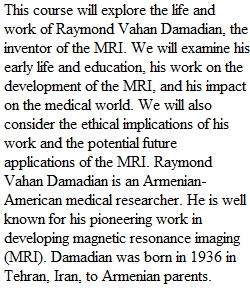


Q Syllabus Prospectus Instructions At this point, you have completed the first stage of the syllabus assignment by naming a central figure. This next stage is the Syllabus Prospectus that includes a course title, course description, and at least one assigned reading. This stage asks you to think a bit more formally about the content of the course. The course title would be the official listing of the course in a catalog. The course description should give a potential student an overview of the course including what topics it will cover and questions it will address. The assigned reading will be a peer-reviewed scholarly article. The Syllabus Prospectus will be a Word or Pdf file that you will upload to the Syllabus Prospectus dropbox. Course Title The course title will be the official name of the class. For the purposes of this assignment, begin with a saying or slogan that you think represents the central figure of the course. This will be followed by a description of the class content that includes the name of your central figure. Here are some examples of potential course titles: • My Way: The Music of Frank Sinatra • From Peanut Farmer to President: The Political Career of Jimmy Carter • Teen Age Riot: Thurston Moore and the Evolution of Punk Course Description Every syllabus has a course description that provides an overview of the class. Your course description should: • Introduce the central figure for the course • Identify major themes and topics in the class • Conclude with some questions the course will consider Feel free to draw material from your syllabus topic discussion post. The course description should be at least 150 words. Assigned Reading Your final syllabus can contain a variety of assigned readings, music clips, videos, and other materials. The prospectus is designed to help you get started by selecting at least one course reading. One requirement for the assigned reading in the prospectus is that it should be a peer-reviewed scholarly article. Not all of the assigned materials in your syllabus will need to be peer-reviewed scholarly articles, but you will need at least one. This could be an article written about your central figure, or it could be a scholarly study about a related subject. You do not need to include the entire article. However, you should list the reading in the form of a bibliographic citation. You can use any citation format you wish (ie., ALA, MLA, Chicago) as long as you consistently follow the style guide. Grading Criteria The assignment will be evaluated using two major criteria: relevance, thoughtfulness, and completeness. Relevance: Full credit will be earned by a syllabus that: • Follows the directions in the syllabus prospectus instructions • Chooses an assigned reading that is relevant to the course topic • Chooses a peer-reviewed scholarly article as the assigned reading Thoughtfulness: Full credit will be earned by discussion participation that: • Provides clear evidence of creative thinking about the potential class • Provides evidence of the willingness to think critically and creatively Completeness: Full credit will be earned by discussion participation that: • Includes a course title, course description, and peer-reviewed scholarly article • Provides a course description of at least 150 words • Includes a full bibliographic citation for the scholarly article
View Related Questions